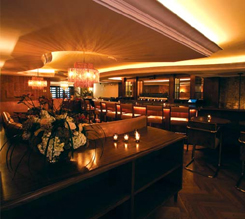A Chef's Plea for Half-Stars at the Times
 Wednesday, December 10, 2008 at 02:16PM
Wednesday, December 10, 2008 at 02:16PM Frank Bruni delivered a shock this week — deliberately, I am sure — by awarding three stars to Corton just seven days after awarding three stars to Momofuku Ssäm Bar. Three-star reviews are pretty rare. There have been just 32 of them in Bruni’s 4½ years on the job. So to give out two of them in a row is unusual. He has never done that before.
Now, the Ssäm Bar review was totally discretionary. No particular event compelled him to write it. By doing so when he knew Corton was coming the following Wednesday, he was clearly trying to make a meta-statement about the very different paths to excellence that these two restaurants have followed.
But the Ssäm Bar review upsets many in the industry, not just because David Chang is ridiculously over-exposed, but because it makes nonsense of the rating system. The same chef’s Momofuku Ko, which is clearly more ambitious and accomplished by any measure, also carries three stars from Frank Bruni. What is the point of a rating system, if it fails to distinguish different levels of excellence and accomplishment?
Over at the Feedbag, an anonymous chef suggests that the Times should add half-stars to its system, to better distinguish between different levels:
The grading of restaurants lately does not make sense. How can a restaurant as refined as Eleven Madison Park, Picholine and Corton fit on the same level as restaurants as casual as A Voce, Scarpetta and the very baffling Momofuku Ssam? I am not saying they aren’t all great restaurants in their own right, but they are not equals. By installing a half star, one could differentiate between them. In my opinion, Blue Hill, Scarpetta and Craft should be 3 stars, Corton, Picholine, and Eleven Madison, 3 and a half, and Momofuku Ssam, 2 and a half. By grouping all of these establishments under the same 3 stars, they are misleading patrons. Isn’t that supposed to be the idea of these reviews? By awarding three stars to restaurants so disparate, they’re making the Times review system meaningless, and that hurts everybody.
We agree that half-stars allow the critic to discriminate better between different types of restaurants. That’s why reviews published on this blog use half-stars.
But ultimately, whether your rating system has 4 grading levels or 100, it can be no better than the person assigning them. I have no idea what ratings Bruni would have given out if his system allowed for half-stars. However, it is poor judgment that has created this mess in the first place, and poor judgment is not rectified by adding levels to the system.
Bruni seems to be applying a bizarre “quality divided by price” formula to assign stars. On that line of reasoning, Ko and Ssäm Bar are rated identically, for although Ko is better, it also costs more. In his defense, Bruni can point out that the Times rating system expressly states that prices are “taken into consideration,” though no past critic has done it quite the way he does.
The same perverted logic allows Bruni to justify awarding three stars to the Bar Room at the Modern, when the obviously superior dining room at the same establishment has just two. We strongly suspect that if the Times had half-stars in its rating system, Bruni would nevertheless have made the same error.
Our own view is that ratings should reflect excellence, period. The fact that excellence costs more is utterly irrelevant to the rating. It may be that some diners either cannot afford the best restaurants, or that they prefer to spend their time and money in other ways. But if Momofuku Ssäm Bar is inferior to Momofuku Ko—as it clearly is—the fact that one is cheaper does not make them equal.





































